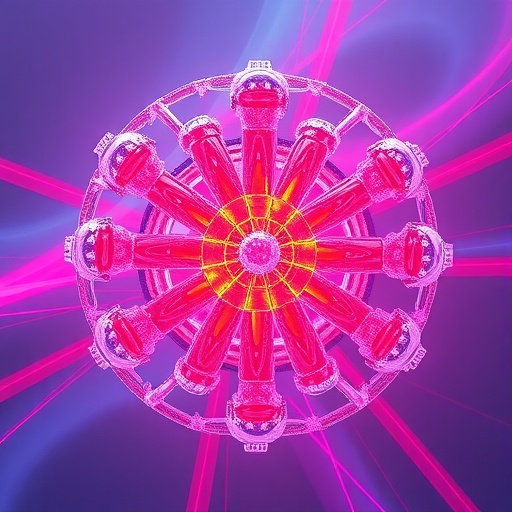In a groundbreaking advancement at the frontier of quantum information science, researchers have successfully demonstrated the preservation of quantum information through long-lived topological edge modes on superconducting processors. This achievement holds immense promise for the development of quantum memories stable at finite temperatures, addressing one of the most formidable challenges in quantum computing: the mitigation of decoherence induced by environmental noise and thermal fluctuations.
Topological edge modes, emerging from the intrinsic properties of the system’s global topology rather than local order parameters, are uniquely robust against a range of perturbations, especially those that respect certain symmetries. Unlike conventional qubits, which are highly susceptible to decoherence via local noise, these modes persist far longer under realistic physical conditions. This robustness stems from how quantum information is encoded nonlocally across the system, effectively shielding it from local disturbances that would otherwise cause rapid fidelity decay.
In this recent study, the authors prepared a logical Bell state using two geometrically adjacent topological edge modes on a superconducting quantum processor. This state, represented as a superposition of joint edge mode configurations, serves as a fundamental resource for quantum communication and computation protocols. The preparation employed targeted local two-qubit gate operations, meticulously engineered to initialize the system directly into this protected subspace.
To probe the longevity and resilience of the logical Bell state, the team explored three distinct coupling regimes: a homogeneous chain where coupling constants were uniform, a dimerized but resonant chain where alternating couplings retained a resonance condition, and a dimerized and off-resonant chain featuring staggered couplings with broken resonance. These regimes allowed the researchers to observe how the interplay of symmetry, coupling strength, and resonance conditions impact the preservation of quantum coherence in real time.
The experimental results revealed a striking hierarchy in the decay dynamics of the logical Bell state. In the uniform coupling scenario, the fidelity—the quantitative measure of how well the state retains its identity—plummeted rapidly to the minimal value of 0.25, effectively indicating maximal mixing and loss of coherence. This rapid decay underscores the vulnerability of quantum information stored in such homogeneous systems to thermal and environmental noise.
Conversely, the dimerized and off-resonant system exhibited dramatically enhanced robustness, with fidelity values sustained close to those observed at near-zero temperatures. This prolonged lifetime signals that off-resonance conditions, combined with dimerization, craft a topological landscape conducive to protecting quantum information by suppressing thermal excitations. The dimerized yet resonant setup occupied an intermediate position, with a fidelity decay rate faster than the off-resonant case but slower than the homogeneous chain, emphasizing the nuanced role of resonance in decoherence processes.
Further insight was gleaned through comprehensive quantum state tomography performed after a 10-unit evolution time. This advanced technique reconstructs the full density matrix of the logical state, enabling a granular view of how quantum coherence and entanglement are preserved or lost. The uniform system’s density matrix collapsed into that of a maximally mixed state—devoid of off-diagonal coherence terms—while the off-resonant system retained significant off-diagonal elements, an unmistakable hallmark of quantum coherence and entanglement.
These findings have profound implications for the practical implementation of quantum memory. Unlike classical bits whose information might be preserved through physical spin polarization at the edges in simpler Ising chains, these topological edge modes afford intrinsic error resilience rooted in symmetry-protected topological order. This protection is particularly formidable as it guards against noise mechanisms that respect the system’s underlying symmetry, a common scenario in realistic quantum processors.
The success of this approach is anchored in its leveraging of “prethermal” strong zero modes — quasiparticles associated with the system’s topological features that commute with the Hamiltonian approximately over extended time scales rather than indefinitely. This prethermal protection, emergent in engineered superconducting chains with tailored couplings, bridges the gap between idealized theoretical models and experimentally realizable quantum devices.
An exciting aspect of the work is its experimental embodiment on state-of-the-art superconducting quantum hardware, showcasing the feasibility of integrating topological error protection in existing quantum computational platforms. By carefully designing the coupling parameters and gate sequences, the team achieved deterministic preparation and probed dynamics that faithfully emulate the behavior of idealized topological chains, thus paving a viable path for scalable quantum error correction.
Moreover, the study highlights that the protection mechanism is effective even at finite physical temperatures, a critical requirement for implementing quantum technologies outside ultracold laboratory conditions. The ability to store quantum states reliably amid thermal excitations provides a realistic path forward for robust quantum memories and fault-tolerant quantum computation architectures.
This experimental advance also differentiates itself from classical digital memories by exploiting the unique quantum phenomenon of entanglement. The logical Bell state formed by the topological edge modes serves not only as a storage medium but also as a resource for distributing entanglement across nodes in future quantum networks, amplifying the broader impact of this research beyond memory lifetimes.
Looking ahead, these results invite further exploration into the interplay between system size, coupling geometry, and environmental noise to fully harness the potential of topologically protected states. Integration with active quantum error correction codes and scalable hardware designs could transform these findings into practical quantum devices capable of tackling classically intractable problems.
In conclusion, the demonstration of long-lived topological edge modes acting as robust quantum memories at finite temperatures is a landmark achievement. It blends fundamental physics and cutting-edge experimental techniques to reveal a promising route for stable quantum information storage, a key stepping stone toward the realization of practical quantum computers and quantum communication systems with unprecedented reliability.
Subject of Research: Long-lived topological edge modes for quantum information storage on superconducting processors
Article Title: Topological prethermal strong zero modes on superconducting processors
Article References:
Jin, F., Jiang, S., Zhu, X. et al. Topological prethermal strong zero modes on superconducting processors. Nature (2025). https://doi.org/10.1038/s41586-025-09476-z
Tags: decoherence mitigation strategiesedge mode configurations in quantum systemsfinite temperature stabilitylogical Bell state preparationlong-lived quantum memoriesnonlocal quantum information encodingquantum communication protocolsquantum information preservationrobustness against environmental noisesuperconducting quantum processorssuperconducting qubit technologytopological edge modes





